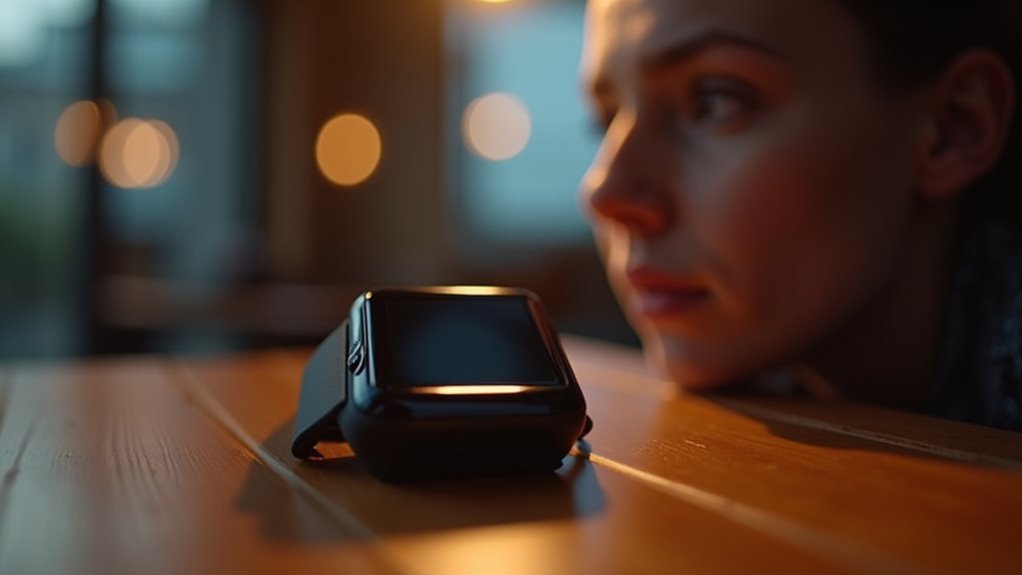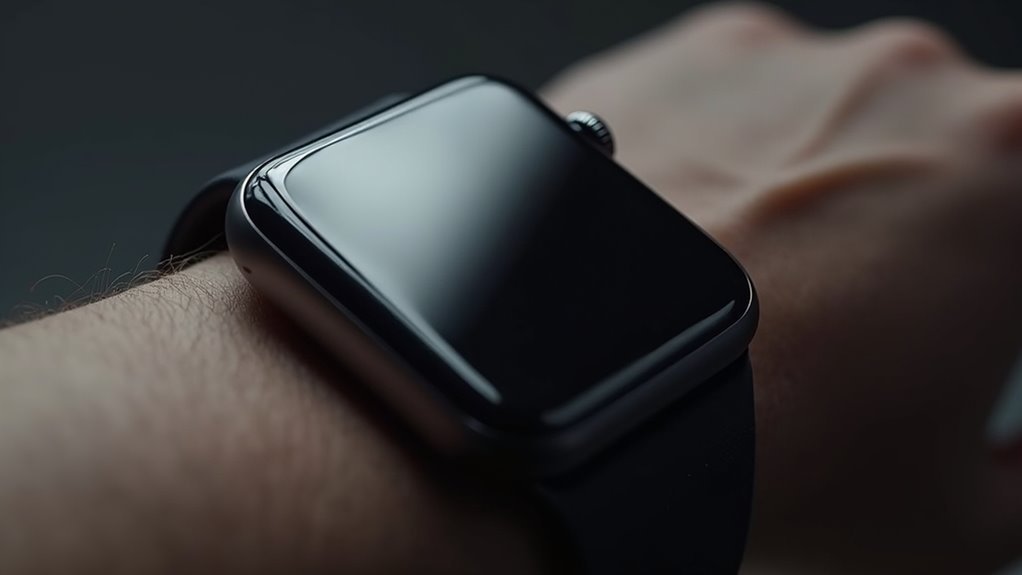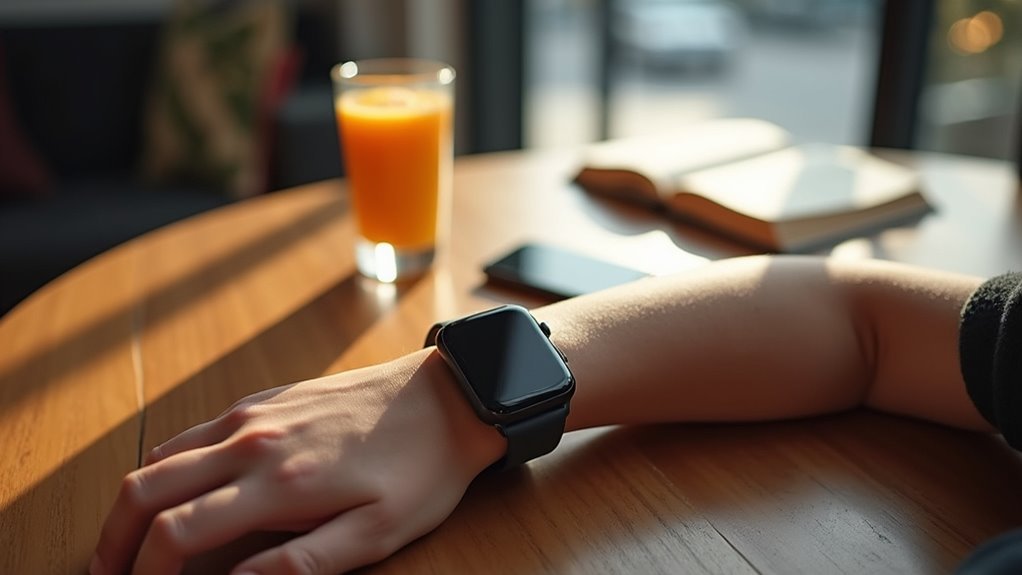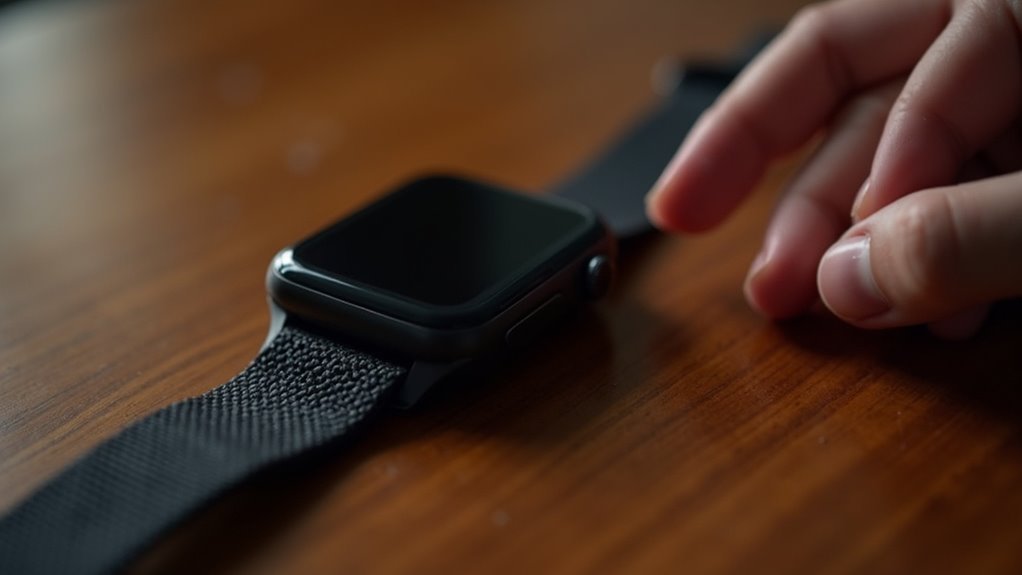Your smartwatch’s facial recognition technology maps 68 distinct points across your face, creating a unique mathematical template that’s stored securely on the device. When you lift your wrist, the camera captures your face while AI algorithms instantly compare it against your stored biometric data using similarity metrics. This hands-free authentication eliminates the need for PINs or patterns, though accessories like sunglasses can affect accuracy. Advanced smartwatches combine multiple biometric methods for enhanced security, and future developments promise even more sophisticated authentication capabilities.
Understanding Biometric Authentication Technology

As technology advances and security threats become more sophisticated, biometric authentication has emerged as a powerful solution that uses your unique biological characteristics to verify your identity. This security process leverages features like your facial geometry, fingerprints, iris patterns, palm prints, or even DNA markers to authenticate who you are.
What makes biometrics so effective is that your biological data is universal, unique, permanent, recordable, and measurable. Unlike passwords you can forget or cards you can lose, your biometric features are always with you.
The technology creates digital models of these characteristics, whether it’s scanning your face’s geometry or analyzing your fingerprint’s unique patterns, providing forgery-proof authentication that’s both secure and convenient for everyday use. Modern systems often employ multimodal biometric approaches that require multiple identifiers, such as combining facial recognition with fingerprint scanning, to create additional layers of security that make it extremely difficult for malicious actors to compromise.
How Facial Recognition Maps Your Unique Features
When you look into a facial recognition system, sophisticated algorithms immediately begin scanning your face to identify dozens of distinctive landmarks like your eye corners, nose tip, and mouth edges.
The system then captures these precise measurements and transforms them into a unique digital template that’s as individual as your fingerprint.
This complex mapping process converts your physical features into mathematical data points that can be stored, compared, and matched against future scans. The entire detection and analysis process happens in mere seconds, enabling quick and seamless user authentication.
Facial Landmark Detection Process
Sixty-eight distinct points map across your face every time a facial recognition system analyzes your features. Your device’s camera first detects your face within its field of view, then sophisticated algorithms predict precise landmark coordinates.
These systems identify key points including your eye corners, nose tip, mouth edges, and eyebrow positions in real-time.
The detection process involves several critical steps:
- Initial positioning – The system makes an educated guess about landmark locations based on your face’s general geometry
- Iterative refinement – Machine learning algorithms continuously adjust coordinates until they converge on precise positions
- Frame-to-frame tracking – For video analysis, previous landmarks serve as starting points for efficient processing
This creates accurate coordinate maps that enable your smartwatch to authenticate your identity within milliseconds. The system exploits structural dependencies between different landmarks to enhance the overall accuracy of facial feature detection.
Creating Your Face Template
Your face becomes a unique mathematical fingerprint once the landmark detection completes its mapping process. The system extracts specific facial features from your image and converts them into a mathematical template that represents you in a multi-dimensional feature space.
Think of it as creating a numerical blueprint that captures your distinctive characteristics.
During template generation, your face gets aligned and cropped for consistency. The system then calculates feature vectors from these processed images and computes your template as a mean vector across all dimensions.
This mathematical representation handles variations in lighting, expressions, and poses while maintaining your unique identity markers. The template operates on a one-to-many basis, comparing your face against multiple stored templates in the database to find the closest match. Your template gets securely stored in an encrypted database, ready for future comparisons when you access your device.
Algorithmic Data Point Mapping
Behind the seamless access of your phone lies a sophisticated algorithmic process that transforms your face into a precise mathematical map. Your device’s camera captures your facial features and converts them into keypoints—specific coordinates that represent unique characteristics like your eye corners, nose bridge, and jawline.
These keypoints become vectors that create your facial signature through advanced mathematical calculations. The algorithm uses techniques like Principal Component Analysis to compress this data while preserving essential identifying information. Modern systems employ convolutional neural networks that process facial data through multiple layers, each detecting different features to enhance recognition accuracy.
- Keypoint Detection: Your facial landmarks are mapped as one-dimensional arrays of critical feature points.
- Vector Mapping: Unique facial characteristics are converted into mathematical vectors for precise representation.
- Facial Encoding: All mapped features combine into a distinctive digital signature for comparison.
This mathematical representation enables instant verification against your stored template.
The Science Behind Facial Template Creation
When you access your smartphone with facial recognition, sophisticated algorithms work behind the scenes to transform your face into a unique mathematical signature called a biometric template.
Convolutional neural networks analyze your facial image through multiple layers, detecting edges, textures, and distinctive features like your eyes, nose, and mouth. The convolution layer applies specialized filters to highlight specific characteristics, while pooling layers reduce computational load by compressing feature maps.
Activation layers introduce non-linearity, enhancing the network’s learning capability by removing negative values. This process generates a compact numerical representation that encodes your essential facial traits.
The resulting template preserves your identifying information while dramatically reducing data size, creating a robust biometric identifier that accommodates variations in lighting, expressions, and aging. Before template creation, pre-processing algorithms enhance the quality of your facial image to ensure optimal feature extraction and matching accuracy.
Camera and Sensor Integration in Smartwatches

As smartwatch technology advances, manufacturers face the unique challenge of cramming sophisticated biometric cameras and sensors into devices barely larger than a postage stamp.
Your smartwatch integrates front-facing miniature cameras near the display bezel, capturing your face when you naturally raise your wrist. These devices don’t rely solely on cameras—they employ sensor fusion for enhanced security and accuracy.
Modern smartwatches combine multiple technologies to create a thorough biometric system:
- Multi-sensor integration – Heart rate monitors, accelerometers, and gyroscopes work together to verify your presence and prevent false positives
- Adaptive imaging – Ambient light sensors automatically adjust camera settings for ideal face capture in varying lighting conditions
- On-device processing – Specialized AI chips handle facial recognition locally, protecting your privacy while minimizing battery drain
The technology can even work effectively with compressed video feeds that were previously considered too low quality for reliable identification.
Real-Time Image Processing and Comparison
Once your smartwatch captures facial images through its integrated cameras and sensors, the real magic happens in milliseconds through sophisticated real-time processing algorithms.
Your device immediately preprocesses images by reducing noise, normalizing lighting, and aligning facial features to standardized coordinates. Deep learning algorithms like convolutional neural networks detect key facial landmarks and encode them into compact biometric templates.
Your smartwatch then compares these templates against stored profiles using similarity metrics such as Euclidean distance or cosine similarity. Threshold-based decision logic determines authentication success instantly.
The entire process is optimized for sub-second speeds through parallel processing and hardware acceleration while maintaining accuracy. Modern wearables like the EmbracePlus platform demonstrate how sophisticated biometric processing can be seamlessly integrated into lightweight devices.
All biometric data remains encrypted and processed locally on your device, ensuring your privacy while providing seamless, continuous authentication without user intervention.
Hands-Free Convenience Vs Traditional Security Methods

While traditional smartwatch security methods require deliberate physical actions—entering PINs, tracing patterns, or pressing fingertips to sensors—facial recognition transforms authentication into an effortless background process.
You’ll experience faster access without memorizing codes or positioning your finger precisely on small sensors. The smartwatch’s form factor actually works in your favor, making it easier to angle your wrist toward your face than fumbling with tiny touchscreens.
This hands-free approach proves especially valuable when:
- Your hands are occupied with tasks, dirty from work, or covered by gloves
- You have limited dexterity or mobility challenges
- You’re engaged in physical activities where traditional input methods become cumbersome
However, environmental factors like poor lighting or face obstructions can affect reliability, unlike traditional methods. The technology creates a unique faceprint from your facial features, similar to how fingerprints work for identification.
Local Data Storage and Encryption Protocols
Three critical layers protect your biometric data when it’s stored locally on your smartwatch: hardware-level encryption, secure storage partitions, and encrypted data formats.
Your device typically uses AES encryption or lightweight protocols like Ascon, which are specifically designed for wearables’ limited computational resources. These protocols guarantee your facial recognition templates and fingerprint data remain secure even if someone physically accesses your device.
You’ll find that manufacturers implement strict access controls, requiring authentication before any app can retrieve your biometric information. Security protocols undergo regular reviews to ensure they remain effective against evolving cyber threats.
However, storage capacity constraints mean your watch can’t store unlimited biometric profiles. The encryption processes do consume additional battery power, but modern devices balance security with performance.
Regular encrypted backups to secure servers protect against data loss while maintaining your privacy through end-to-end encryption protocols.
Privacy Protection in Wearable Devices
Beyond the technical safeguards that protect your biometric data at the device level, broader privacy considerations shape how wearable manufacturers handle your personal information throughout its entire lifecycle.
Privacy protection extends far beyond your device, encompassing how companies manage your personal data from collection to deletion.
You’ll find that 79% of surveyed professionals consider privacy concerns a significant barrier to biometric adoption in wearables.
Your rights are protected through various regulations:
- Explicit consent requirements – Laws like GDPR and CCPA mandate that companies obtain your clear permission before collecting biometric data.
- Data deletion rights – You can request that companies remove your stored biometric information from their systems.
- Opt-out protections – Regulations give you the power to withdraw from biometric data collection at any time.
However, cloud storage remains a vulnerability, making industry transparency about security practices essential for gaining your trust. Leading manufacturers implement state-of-the-art encryption technologies to safeguard user information during transmission and storage.
Addressing Lighting and Environmental Variables
Environmental conditions pose significant challenges for facial recognition systems in wearable devices, yet modern biometric technology has developed sophisticated solutions to maintain accuracy across diverse settings.
You’ll benefit from advanced cameras equipped with high dynamic range sensors and infrared illumination that adapt to varying light conditions, from bright sunlight to complete darkness. These systems automatically adjust exposure and focus in real-time, ensuring consistent performance.
AI algorithms trained on diverse datasets compensate for shadows, reflections, and partial obstructions while filtering environmental noise. You can optimize your device’s performance through proper calibration in different lighting conditions and following positioning guidance.
Multispectral imaging technology further enhances reliability by capturing facial features across multiple light spectrums, making your face access work seamlessly regardless of environmental variables. However, the implementation of facial recognition on wearables raises important privacy concerns that manufacturers must address through transparent data handling policies and secure local processing methods.
Battery Life Impact of Continuous Processing
While facial recognition technology delivers seamless authentication, you’ll notice that continuous biometric processing greatly impacts your device’s battery performance.
Your smartwatch’s face recognition algorithms require sustained sensor activity and high sampling rates, which can increase battery drain by up to 30%. This means your multi-day battery life might shrink to just one day or less with always-on biometric features.
Several factors influence this power consumption:
- Dual-wavelength sensors and AI algorithms demand more processing power than basic biometric systems
- Multiple active sensors (camera, accelerometer) compound the battery drain effect
- Event-triggered activation helps preserve battery life compared to continuous monitoring
You’ll need to balance authentication convenience against charging frequency, as battery limitations considerably affect user acceptance and long-term device adoption. Smartwatches with superior battery longevity like Garmin and Amazfit models can better accommodate continuous biometric processing without requiring daily charging that hinders comprehensive data collection.
Accuracy Challenges With Accessories and Obstructions
Accessories and environmental obstructions create significant accuracy challenges that often outweigh battery concerns in real-world smartwatch usage.
When you’re wearing sunglasses, hats, or face masks, these items obscure key facial features that algorithms need for accurate identification. You’ll find that reflections on eyeglasses can distort your facial image, leading to false rejections.
Environmental factors compound these problems. Harsh lighting, shadows, and low-light conditions impair your smartwatch camera’s ability to capture clear facial details.
Background clutter and camera angle deviations from wrist movements further reduce recognition success rates.
Unfortunately, current facial recognition systems embedded in smartwatches have limited computational power and often struggle with demographic bias, showing higher error rates for non-white populations, especially when accessories cause partial face occlusion. These accuracy issues become particularly concerning in mandatory monitoring contexts where false rejections can have serious consequences for individuals.
Multi-Biometric Integration Approaches
To overcome the limitations of single-biometric systems, smartwatch manufacturers now integrate multiple authentication methods that work together to improve accuracy and reliability.
You’ll find that modern wearables combine fingerprint sensors, face recognition, voice authentication, and even iris scanning to create layered security. When one method fails due to accessories or environmental factors, backup systems automatically engage.
These multi-biometric approaches offer several key advantages:
- Enhanced Security: Multiple authentication layers make counterfeiting nearly impossible since duplicating several biometric patterns simultaneously is extremely difficult.
- Improved User Experience: Seamless fallback options eliminate authentication frustration when primary methods encounter obstructions.
- Real-Time Adaptation: Advanced algorithms analyze which biometric modality works best in your current environment and prioritize accordingly.
Some advanced wearables even incorporate heartbeat biometrics for continuous authentication throughout your workday, ensuring persistent security without requiring repeated manual verification.
This integration guarantees you’ll rarely encounter authentication failures while maintaining top-tier security standards.
Deep Learning Algorithms in Wearable Technology
You’ll find that neural networks in wearable devices pack impressive processing power that can analyze your biometric data in real-time.
These algorithms require massive training datasets to learn your unique patterns and achieve the accuracy you need for reliable identification.
The key to their success lies in balancing lightning-fast recognition with precision that won’t compromise your security or user experience. Modern wearables can monitor diverse health parameters while simultaneously processing facial recognition data for seamless device authentication.
Neural Networks Processing Power
While traditional computing struggles with the complex calculations required for real-time biometric analysis, neural networks have revolutionized how wearable devices process and interpret physiological data. Your smartwatch now uses lightweight 1D CNNs and attention mechanisms to analyze PPG signals and gait patterns with minimal battery drain. These specialized architectures capture long-range dependencies in your physiological data while maintaining the efficiency needed for continuous monitoring. Neural networks excel at handling the vast data generated from wearable devices, requiring significant computational processing to transform raw biometric signals into actionable authentication decisions.
- On-device processing: Neural networks analyze your biometric data locally, protecting privacy while reducing latency for instant authentication.
- Adaptive learning: Models fine-tune themselves to your unique physiological patterns, improving accuracy over time through transfer learning techniques.
- Resource optimization: Streamlined architectures balance processing power with battery life, enabling real-time authentication without compromising device performance.
Algorithm Training Data Sets
The sophisticated neural networks powering your wearable device’s biometric analysis depend entirely on the quality and diversity of their training datasets. Your device’s accuracy stems from algorithms trained on massive collections of biometric data gathered from continuous monitoring of heart rates, blood oxygen levels, and other physiological markers.
These datasets must include diverse samples across different demographics and conditions to prevent bias and guarantee your device works reliably regardless of your background. Researchers combine publicly available datasets with custom collections, carefully annotating and preprocessing the data to remove noise and outliers.
The training process enables pattern recognition for user authentication and anomaly detection for health monitoring. Military applications have demonstrated that real-time analysis through deep learning networks can provide rapid predictions essential for high-stress operational environments. Without high-quality, varied training data, your wearable’s deep learning algorithms couldn’t accurately recognize your unique biometric patterns or detect potential health issues.
Real-Time Recognition Accuracy
When your smartwatch analyzes your heart rate variability or stress levels in real-time, deep learning algorithms achieve impressive accuracy rates of around 85% for emotion classification across six target categories.
These systems combine CNN and LSTM models to capture both spatial and temporal features, with hybrid approaches outperforming individual algorithms. You’ll experience minimal latency as your wearable processes multiple physiological signals simultaneously.
However, real-world conditions present challenges that can slightly reduce performance:
- Environmental noise and data variability affect classification consistency during daily activities
- Hardware constraints limit computational complexity on resource-restricted wearable devices
- Battery life concerns arise from continuous sensing and wireless data transmission requirements
Despite these limitations, you’ll benefit from instantaneous emotion recognition that adapts to your unique facial features and behavioral patterns. AI algorithms in healthcare can reduce response time to critical events by up to 50%.
Future Developments in Smartwatch Security
As biometric technology rapidly evolves, you’ll witness smartwatches transform into sophisticated security hubs that go far beyond today’s basic fingerprint sensors and heart rate monitors. You’ll experience enhanced face recognition powered by AI-driven insights that analyze behavioral patterns for predictive security threats. Privacy-centric designs will process your biometric data directly on-device, eliminating remote server transfers.
| Security Feature | Current State | Future Development |
|---|---|---|
| Authentication | Single biometric | Multi-factor combinations |
| Data Processing | Cloud-dependent | On-device only |
| Integration | Limited platforms | Universal authentication device |
| Threat Detection | Reactive | AI-powered predictive analysis |
You’ll enjoy seamless authentication across multiple platforms while your smartwatch serves as a master security key. These devices will integrate with workplace platforms like Microsoft Teams and Slack to create secure, biometric-enabled access to your professional tools. Decentralized blockchain storage will protect your data, and regular updates will defend against evolving threats automatically.
Frequently Asked Questions
Can Facial Recognition Still Work if I’m Wearing a Face Mask?
Yes, you can use facial recognition while wearing a mask, though accuracy drops considerably. Advanced systems trained for masks can achieve up to 95% accuracy by focusing on your eyes and forehead area.
Will My Watch Recognize Me After Significant Weight Loss or Aging?
Significant weight loss or aging can reduce your watch’s recognition accuracy by altering facial contours and features. You’ll likely need to re-register your face data to maintain reliable access performance.
Can Someone Else Unlock My Watch Using My Photo?
You shouldn’t worry about photo attacks with modern smartwatches. They use liveness detection and infrared scanning to verify blood flow, ensuring only your living face opens the device, not photos.
Does Facial Recognition Work in Complete Darkness?
Traditional facial recognition won’t work in complete darkness since it needs visible light. However, you’ll find infrared thermal imaging systems can recognize faces using heat signatures, though they’re expensive and require specialized databases.
What Happens if My Watch’s Camera Gets Dirty or Damaged?
If your watch’s camera gets dirty, you’ll experience reduced face recognition accuracy and frequent access failures. Clean it gently with microfiber cloth. Physical damage can permanently disable facial recognition features.
In Summary
You’re witnessing the evolution of wearable security as facial recognition transforms how you’ll interact with smartwatches. While current technology faces challenges with lighting and obstructions, you can expect dramatic improvements through deep learning integration. You’ll soon enjoy seamless multi-biometric authentication that combines facial recognition with other unique identifiers. As processing power increases and algorithms advance, you’ll experience faster, more accurate access that adapts to your daily routine effortlessly.




Leave a Reply